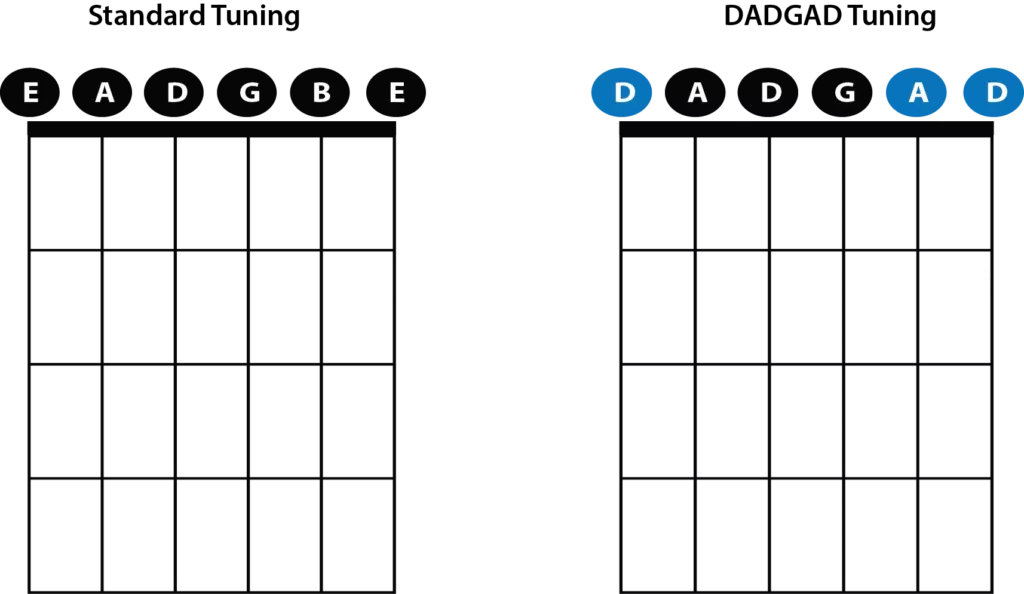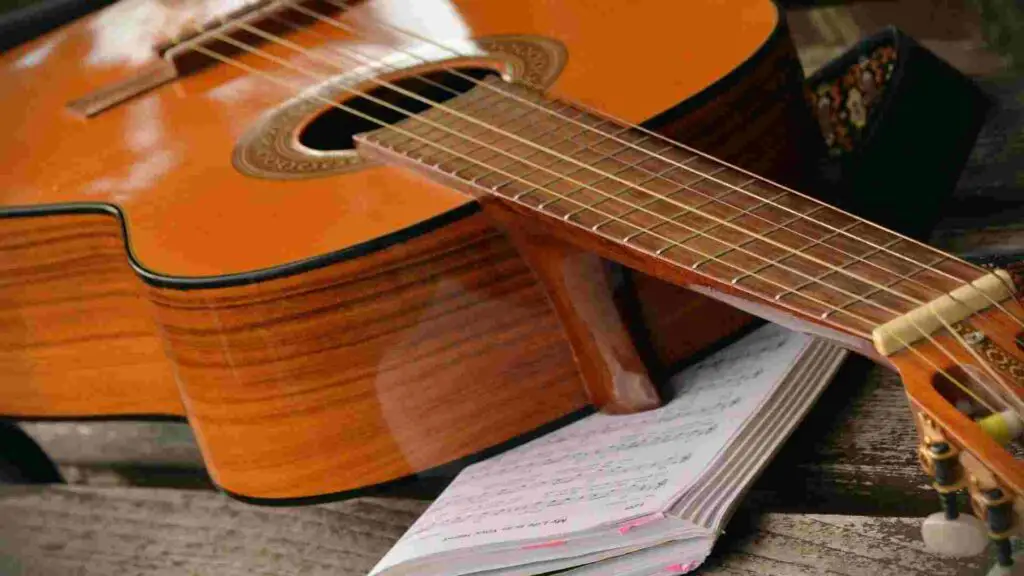As a guitarist, you want to improve your guitar skills and one unique way of doing it is by experimenting with alternate tunings.
There is a wide variety of tunings that guitarists use in all kinds of creative ways to create intriguing sounds. One of these tunings is called DADGAD tuning.
In this lesson, we will take an in-depth look at:
- What is DADGAD tuning?
- How to tune to DADGAD tuning?
- Why learn DADGAD tuning?
- Popular songs that uses DADGAD tuning
What is DADGAD tuning?
The DADGAD tuning is an alternate (open) tuning where the thickest (E) and bottom two thinnest ( B and E ) strings are tuned down a whole step ( by two semitones ) from the typical Standard tuning. As a result, it produces a Dsus4 ( D suspended 4th) chord when all the six strings are strummed open without fretting any notes.
This tuning was popularized in the early 60s, by British folk guitarist Davey Graham and is most associated with Celtic music and other genres like rock, folk, metal, Indian, etc.
In modern times, this tuning is adopted by numerous guitar players including Jimmy Page, Roy Harper, Jeff Tweedy, and Rory Gallagher.
The name DADGAD comes from how the strings are tuned from lowest to highest.
In standard tuning, the strings are tuned to:
- E (Lowest)
- A
- D
- G
- B
- E (Highest)
While in DADGAD tuning, the E (lowest), B and E (highest) strings are tuned down by a whole step ( by 2 frets ). Hence in DADGAD tuning, the strings are tuned to:
- D (Lowest)
- A
- D
- G
- A
- D (Highest
Now that you know a little bit about the difference between Standard and DADGAD tuning, let’s look at how to tune a guitar to DADGAD tuning.
How to tune to DADGAD tuning?
Tuning to DADGAD from the standard tuning is quite simple. All you have to do is tune your first, second, and sixth strings down a whole step ( by two semitones ). Follow the step-by-step instruction if this sounds confusing.
Valuable Tip – Remember to always keep a tuner handy while changing the tuning of your guitar strings. This will ensure that your new tuning is as accurate as possible.

Step-By-Step Tuning Guide for DADGAD tuning:
- Start by plucking the 6th (E) String (lowest string) and keep turning the tuning peg until it shows the note D in the tuner
- The 5th (A), 4th (D) and the 3rd (G) strings will remain the same
- Next, tune the 2nd (B) string down a tone to A
- Lastly, take your 1st (E) (thinnest string) and tune it down a whole step to D
That’s all.
So, basically what we did is, tuned the E (lowest) string down a whole step to D, tuned the standard B string down a whole step to A, and lastly we tuned the standard E (highest) string down a whole step to D. Not to forget, the 5th (A), 4th (D) and 3rd (G) strings remain unchanged.
Now, with these small tweaks in the tuning, your guitar is now transformed completely into a new instrument, thus opening a new world of musical possibility with a whole new array of chord shapes, scales, and melodies.
Why learn DADGAD Tuning?
The thing with DADGAD or any alternate tuning is that it provides a fresh new canvas for experimentation and improvisation because all your guitar strings are completely changed to a new tuning.
No longer you will be able to default to that minor pentatonic lick or chord progressions you have practiced for hours in standard tuning.
Now, as you will start to explore this new tuning, new creative things will come out which will certainly expand your range of musical capabilities on the instrument.
Apart from this, one of the biggest reasons why guitarists use the DADGAD tuning is, it allows them to produce those rich, ambient, and atmospheric sounds by merely fretting one or two notes on the fretboard, taking full advantage of the open strings.
Also Read: DADGAD Chords, Scales, Songs and Tabs
Here is a video by Music is Win, where he explains the magic of this tuning.
“DADGAD’s open A, D and G strings are the same as in standard tuning! That means 50 percent of this tuning is completely familiar to you.”
Martin Simpson
Popular Songs that uses DADGAD tuning
There are tons of songs that use the DADGAD tuning, but one of the most popular songs that use this incredibly versatile tuning is ‘Kashmir’ by Led Zepellin.
Jimmy Page is a huge fan of DADGAD tuning and has literally shown us how to put this amazing tuning to proper use and produce some life-changing riffs through this song.
Not to forget, Page has also used DADGAD tuning in his early instrumentals like ‘White Summer’ and ‘Black Mountain Side’.
Also Read - 12 Popular Songs in DADGAD tuning
Another song that uses this tuning is ‘Photograph’ by Ed Sheeran. He wrote this one along with Johnny Mcdaid and shown us how to use DADGAD tuning to create some amazing sounds while keeping things simple.
This song has merely four open chords but the sound they managed to achieve through this tuning is really fascinating.
List of Songs that uses DADGAD tuning:
- The Only boy awake by Meadows
- Dear Maria Count Me In by All Time Low
- Tell Her This by Del Amitri
- In Dreams by Ben Howard
- Drifting by Andy McKee
Summing Up
It is no longer a secret that alternate tunings can give a fresh new perspective and provide a blank slate to fill it up with new creative ideas.
However, switching to these (alternate) tunings and getting comfortable with them can be challenging at first as it pushes you to learn new things from the start. Nevertheless, this will be all worth it once you start to create those fascinating and magical sounds this tuning has to offer.
If you still reading, then I highly suggest you to get your hands in this amazing tuning and start experimenting today. Here is a post, which will take you through all the basic chords shapes and scale patterns in DADGAD tuning that you may find helpful.




